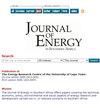南非综合能源规划框架,2015-2050
IF 0.6
4区 工程技术
Q4 ENERGY & FUELS
引用次数: 1
摘要
综合能源计划(IEP)旨在考虑南非从2015年到2050年的能源需求,作为能源结构节约和能源政策发展的指南。能源部的主要目标是确保能源供应的安全。该国目前的能源形势既有好处,也有挑战。随着人口的增长和基础设施的发展,该国需要采取谨慎措施来满足该国2020-2050年的能源需求。该国的能源目前以燃煤电厂为主,约占总装机容量的70%,原油约占21%,包括可再生能源在内的所有其他能源仅占9%。本文探讨了国际经济政策框架的范围、国际经济政策的主要目标、实现这些目标所采用的方法,以及为实现框架目标所做的预测。本文进一步回顾了经济关键部门的能源需求,并分析了整个时期二氧化碳排放的影响和创造就业机会的好处。尽管南非的可再生能源潜力巨大,但目前它只占能源结构的2%。关于减少二氧化碳排放、提高能源效率和部署可再生能源发展的全球可再生能源政策在IEP框架中没有得到满足。本文章由计算机程序翻译,如有差异,请以英文原文为准。
South Africa’s integrated energy planning framework, 2015–2050
The Integrated Energy Plan (IEP) was designed to consider South Africa’s energy needs from 2015 to 2050, as a guide for energy structural savings and the development of energy policy. The main aim of the Department of Energy is to ensure the security of energy supply. The current energy situation in the country has its gains and challenges. With the growing population and infrastructural development, the country requires prudent measures to meet the country’s energy needs for 2020–2050. The country’s energy is currently dominated by coal-fired plants, which represent about 70% of the total installed capacity, crude oil contributes about 21%, with only 9% from all other energy sources, including renewables. This paper examines the scope of the IEP framework, key objectives of the IEP, the methodology applied to achieve those objectives, and the projections made for attaining the framework target. The paper further reviews the energy requirements for the key sectors of the economy and analyses the effects of CO2 emissions and the benefits of job creation for the entire period. Despite substantial renewable potential in South Africa, at present it contributes as little as 2% of the energy mix. The global renewable energy policy on CO2 emissions reduction, improvement of energy efficiency and deployment of renewable development are not met in the IEP framework.
求助全文
通过发布文献求助,成功后即可免费获取论文全文。
去求助
来源期刊

Journal of Energy in Southern Africa
ENERGY & FUELS-
CiteScore
3.00
自引率
0.00%
发文量
16
审稿时长
6 months
期刊介绍:
The journal has a regional focus on southern Africa. Manuscripts that are accepted for consideration to publish in the journal must address energy issues in southern Africa or have a clear component relevant to southern Africa, including research that was set-up or designed in the region. The southern African region is considered to be constituted by the following fifteen (15) countries: Angola, Botswana, Democratic Republic of Congo, Lesotho, Malawi, Madagascar, Mauritius, Mozambique, Namibia, Seychelles, South Africa, Swaziland, Tanzania, Zambia and Zimbabwe.
Within this broad field of energy research, topics of particular interest include energy efficiency, modelling, renewable energy, poverty, sustainable development, climate change mitigation, energy security, energy policy, energy governance, markets, technology and innovation.
 求助内容:
求助内容: 应助结果提醒方式:
应助结果提醒方式:


